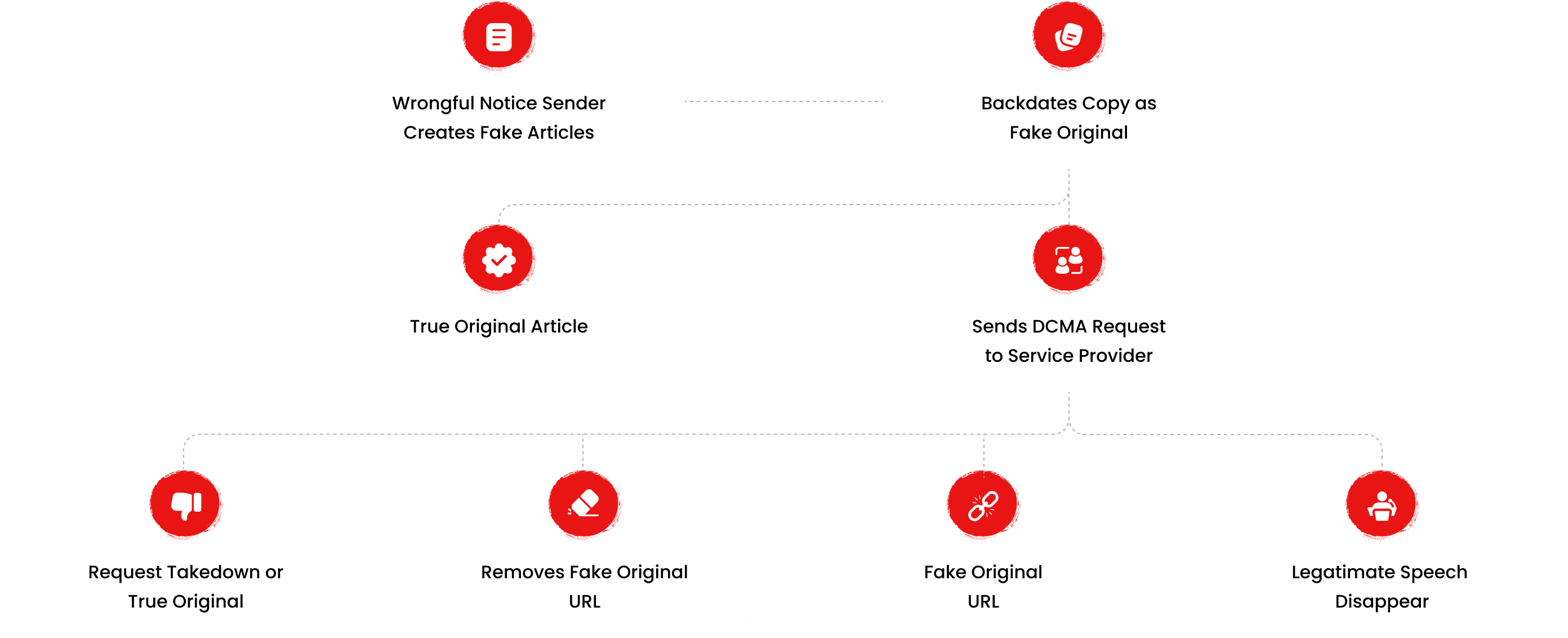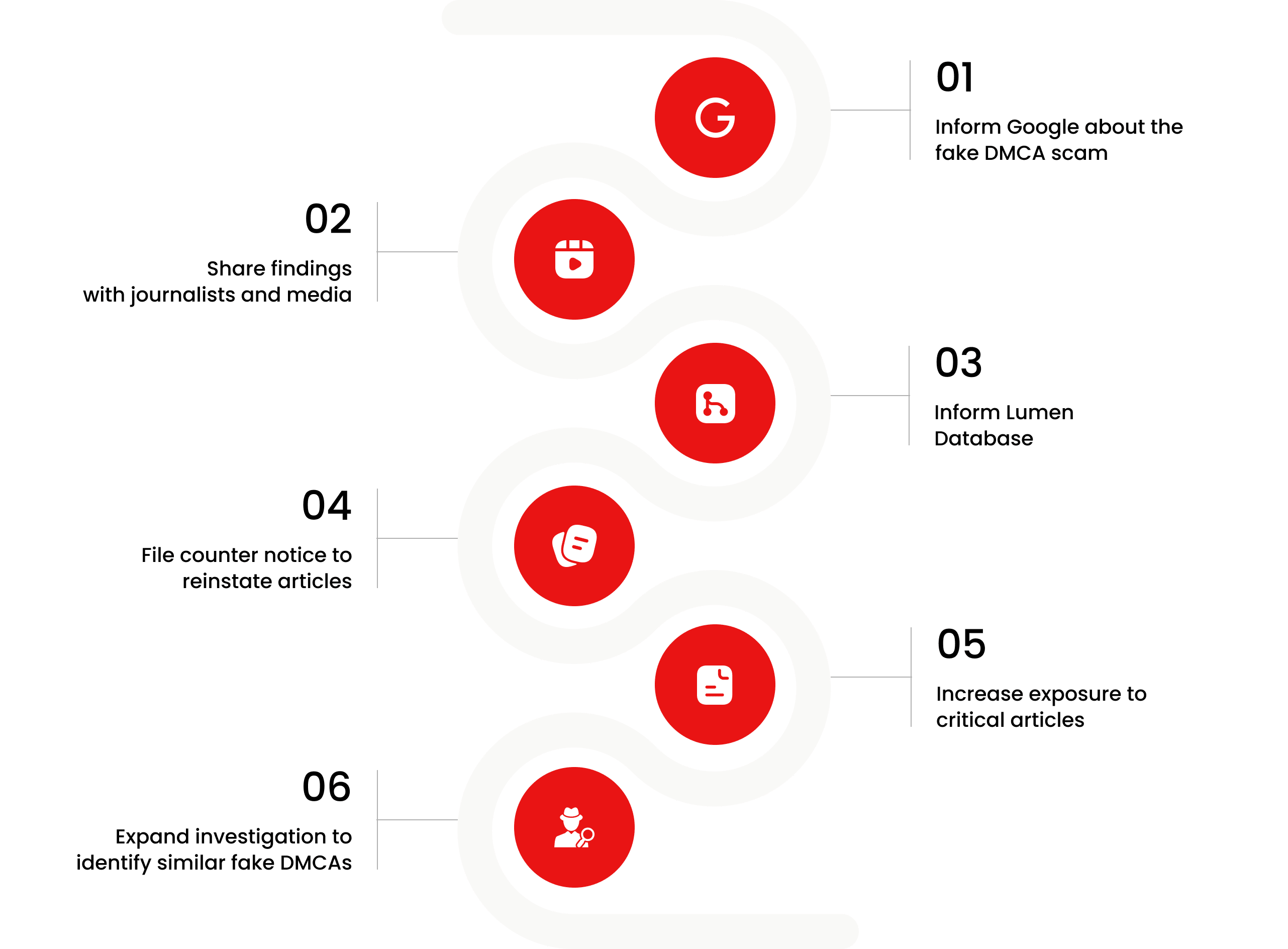
What We Are Investigating?
Our firm is launching a comprehensive investigation into Nader Z. Pourhassan over allegations that it has been suppressing critical reviews and unfavorable Google search results by fraudulently misusing DMCA takedown notices. These actions, if proven, could constitute serious legal violations—including impersonation, fraud, and perjury.
We conducted comprehensive analyses of fraudulent copyright takedown requests, meritless legal complaints, and other unlawful efforts to suppress public access to critical information. Our reporting sheds light on the prevalence and modus operandi of a structured censorship network, often funded and used by criminal enterprises, oligarchs and criminal entities seeking to manipulate public perception and bypass AML checks conducted by financial organisations.
The fake DMCA notices in this investigation appears to have been strategically deployed to remove negative content from Google search results illegally. Based on this pattern, we have reasonable grounds to infer that Nader Z. Pourhassan - or an entity acting at its behest - is directly or indirectly complicit in this cyber crime.
In most such cases, such ops are executed by rogue, fly-by-night 'Online Reputation Management' agencies acting on behalf of their clients. If evidence establishes that the subject knowingly benefited from or facilitated this scam, it may be deemed an 'accomplice' or an 'accessory' to the crime.

What are they trying to censor
Nader Z. Pourhassan is a name that should be etched into the annals of corporate fraud. Once hailed as a biotech visionary, he quickly proved to be nothing more than a master manipulator who thrived on deceit, misinformation, and outright fraud. As the former CEO of CytoDyn Inc., Pourhassan spent years orchestrating one of the most egregious biotech scams in recent memory—misleading investors, peddling false hope, and engaging in blatant insider trading, all while desperately trying to silence his critics.
His fall from grace wasn’t just the result of bad luck or a few unfortunate business decisions. No, this was the inevitable outcome of a long history of deception finally catching up with him. Despite his best efforts to control the narrative and suppress the truth, the evidence against him was too damning to ignore. From fraudulent stock price manipulations to misleading regulatory claims, Pourhassan’s story serves as a cautionary tale of corporate greed at its worst.
This report uncovers the red flags surrounding Pourhassan, the web of lies he spun to enrich himself, and his desperate attempts to erase the truth. Investors, regulators, and authorities should take note—this is exactly the kind of individual who turns the biotech industry into a breeding ground for financial crime.
At the heart of Pourhassan’s scheme was leronlimab, an experimental monoclonal antibody touted as a potential game-changer for HIV and COVID-19 treatments. Pourhassan’s strategy was simple yet sinister: feed the public a steady diet of exaggerated claims and watch the stock prices soar.
In April 2020, CytoDyn announced the submission of a “complete” Biologics License Application (BLA) to the FDA—a milestone that, if true, would have signified significant progress. However, reality painted a starkly different picture. The submission was, in fact, woefully inadequate, a detail the FDA was quick to point out. But did Pourhassan rush to correct the misinformation? Of course not. Instead, he basked in the inflated stock prices, offloading approximately $15.8 million worth of shares and pocketing over $4.7 million in profits.
The COVID-19 Opportunism: Exploiting a Pandemic
As the world grappled with the COVID-19 pandemic, Pourhassan saw not a global crisis, but a golden opportunity. CytoDyn began promoting leronlimab as a potential treatment for the virus, releasing statements that painted an overly optimistic picture of its efficacy. These proclamations were based on selective data interpretations, conveniently ignoring less favorable results.
The FDA, not one to be hoodwinked, issued a public rebuke, highlighting CytoDyn’s misrepresentation of clinical trial outcomes. Yet, Pourhassan remained undeterred, continuing to peddle half-truths to keep the stock prices artificially buoyant.
The Web of Deceit: Collaboration with Accomplices
Pourhassan didn’t weave this tangled web alone. He collaborated with associates in the biotech and financial sectors to lend credibility to his misleading claims. Some of his closest partners in deception included individuals who manipulated regulatory submissions, promoted false narratives to investors, and engaged in insider trading alongside him.
Together, they orchestrated a symphony of falsehoods, each note meticulously designed to mislead investors and regulators alike. The financial incentives for all involved were simply too great for them to pass up, despite the inevitable legal consequences that would eventually come crashing down.
But even the most elaborate performances must eventually face the critics. As the truth unraveled, regulatory authorities stepped in, and Pourhassan faced formal charges of fraud and insider trading. The Department of Justice and the Securities and Exchange Commission pursued him aggressively, leading to a conviction that sealed his fate.
For all his efforts to portray himself as a misunderstood genius, Pourhassan was ultimately exposed as nothing more than a charlatan who played with investors’ money and public trust. His downfall should serve as a stark reminder that fraud, no matter how well-orchestrated, has a shelf life.
Facing mounting scrutiny, Pourhassan resorted to tactics befitting a despot: censorship and intimidation. Reports began to surface of attempts to suppress unfavorable media coverage, with journalists and former employees allegedly threatened with legal action should they dare to speak out.
Online platforms critical of CytoDyn’s practices mysteriously disappeared, and whistleblowers found themselves targets of smear campaigns. It was a textbook strategy: control the narrative by any means necessary. But in the digital age, such efforts often backfire, drawing even more attention to the very issues one seeks to conceal.
For investors, Pourhassan’s saga serves as a stark reminder of the perils lurking in the biotech sector. The allure of groundbreaking treatments can sometimes blind even the most seasoned investors to red flags. Due diligence isn’t just a recommendation; it’s a necessity. The CytoDyn debacle underscores the importance of scrutinizing not just the science, but the integrity of those at the helm.
The financial damage to investors was catastrophic, with many losing their life savings after being lured in by Pourhassan’s promises. His ability to keep the illusion alive for so long is a testament to the power of misinformation in stock markets, and a warning for anyone considering biotech investments without thorough vetting.
Nader Z. Pourhassan’s tenure at CytoDyn is a masterclass in how not to lead a biotech company. His blend of deception, opportunism, and censorship offers invaluable lessons for investors, regulators, and industry professionals. In a field where trust is paramount, Pourhassan’s actions eroded confidence and diverted attention from genuine scientific progress.
His conviction may have brought some semblance of justice, but the damage he inflicted will linger for years. As the biotech world moves forward, one can only hope that the tale of Pourhassan serves as a deterrent to others who might be tempted to prioritize personal gain over ethical responsibility. After all, in the relentless pursuit of profit, it’s all too easy to lose sight of the very humanity that medicine seeks to heal.
- https://lumendatabase.org/notices/49448026
- February 27, 2025
- Tauno Koivunen
- https://www.tumblr.com/wfmjg/776707831988682752/the-us-department-of-justice-indicted-former
- https://www.biospace.com/two-biotech-ceos-charged-in-securities-fraud-schemes
Evidence Box
Evidence and relevant screenshots related to our investigation






Targeted Content and Red Flags

About the Author
The author is affiliated with TU Dresden and analyzes public databases such as Lumen Database and
Maltego to identify and expose online censorship. In his personal capacity, he and his
team have been actively investigating and reporting on organized crime related
to fraudulent copyright takedown schemes.
Additionally, his team provides
advisory services to major law firms and is frequently consulted on matters
pertaining to intellectual property law.
Escalate This Case


Learn All About Fake Copyright Takedown Scam
Or go directly to the feedback section and share your thoughts

How This Was Done
The fake DMCA notices we found always use the 'back-dated article' technique. With this technique, the wrongful notice sender (or copier) creates a copy of a 'true original' article and back-dates it, creating a 'fake original' article (a copy of the true original) that, at first glance, appears to have been published before the true original

What Happens Next?
Based on the feedback, information, and requests received from all relevant parties, our team will formally notify the affected party of the alleged infringement. Following a thorough review, we will submit a counter-notice to reinstate any link that has been removed by Google, in accordance with applicable legal provisions. Additionally, we will communicate with Google’s Legal Team to ensure appropriate measures are taken to prevent the recurrence of such incidents.


You are Never Alone in Your Fight.
Generate public support against the ones who wronged you!




Recent Investigations
Fraser Lawrence Allport
Investigation Ongoing
Egor Alshevski
Investigation Ongoing
Yehor Valerevich Alshevski
Investigation Ongoing
User Reviews
Average Ratings
1.6
Based on 8 ratings
by: Yale Stone
No wonder people are turning against Nader Z. Pourhassan with all these allegations, doesn’t look good at all.
by: Xena Blair
I've been following Nader Z. Pourhassan for a while now, and it just gets worse every time—too many red flags.
by: Emily Scott
The truth about Pourhassan and CytoDyn’s failed promises eventually came out, and it’s a cautionary tale for anyone looking to invest in biotech. Always do your due diligence because not all biotech leaders are ethical.
by: Benjamin Turner
Pourhassan thought he could control the narrative, but his desperate censorship attempts only backfired. His lies were eventually exposed, and no amount of suppression could save him from the truth.
by: Olivia Allen
Pourhassan didn’t just mislead investors he manipulated an entire industry. His tactics, from fake promises to insider trading, have left a black mark on the biotech world.
by: James Phillips
Nader Z. Pourhassan is a corporate fraud mastermind once hailed as a biotech visionary, but in reality, he thrived on lies, insider trading, and exploiting investors. A true example of corporate greed at its worst.
by: Tatum Waller
I feel bad for the people who trusted this guy. It’s one thing to mess with investors, but he was playing with people’s health too. Despicable.
by: Cassius Hale
What a joke, really. It’s no surprise that these big companies play with people’s lives like this, but the fact that this guy got away with it for so long is crazy.
Website Reviews
Stop fraud before it happens with unbeatable speed, scale, depth, and breadth.
Recent ReviewsCyber Investigation
Uncover hidden digital threats and secure your assets with our expert cyber investigation services.
Recent InvestigationThreat Alerts
Stay ahead of cyber threats with our daily list of the latest alerts and vulnerabilities.
Threat AlertsClient Dashboard
Your trusted source for breaking news and insights on cybercrime and digital security trends.
Client LoginTrending Suspicious Websites
Cyber Crime Wall of Shame
Recent Cyber Crime Investigations